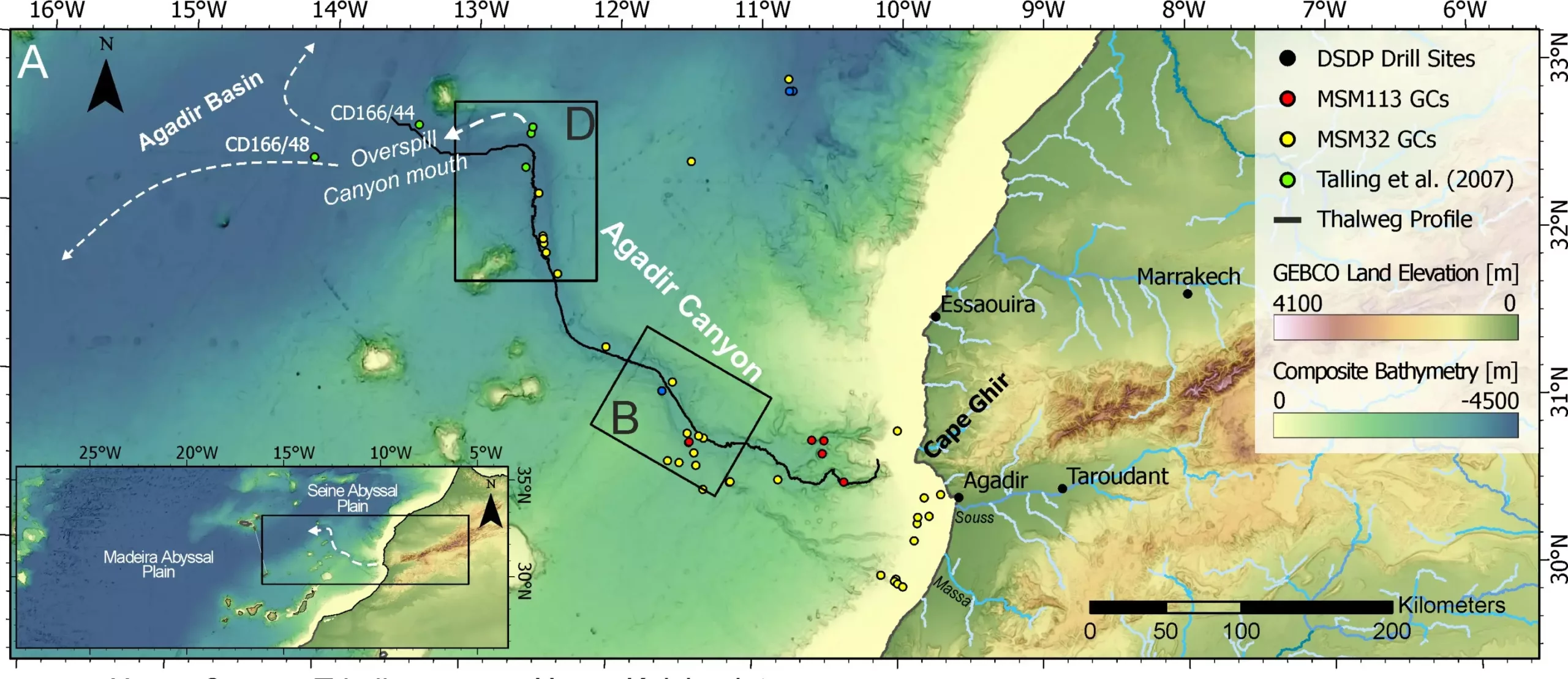Underwater avalanches, though elusive and difficult to study, play a crucial role in shaping the ocean’s seafloor. Recent research from the University of Liverpool sheds light on these phenomena, particularly focusing on an event that occurred almost 60,000 years ago in the Agadir Canyon located off the North West coast of Africa. This study provides an extraordinary glimpse into the dynamics of underwater avalanches, revealing just how these subterranean disasters can grow from relatively minor disturbances into colossal forces of nature.
The research, published in the journal *Science Advances* and entitled “Extreme erosion and bulking in a giant submarine gravity low,” illustrates the immense scale and impact of a specific underwater avalanche. Initially a modest landslide, the event evolved into a destructive force, expanding over 100 times in size and demonstrating a trail of devastation as it journeyed 2,000 kilometers across the Atlantic Ocean’s seafloor. This metamorphosis emphasizes the potential of underwater avalanches to transform landscapes while remaining hidden from immediate observation.
Dr. Chris Stevenson, a sedimentologist and one of the study’s co-leaders, echoes the study’s significance by stating that it represents the first comprehensive mapping of a large submarine avalanche. Through examination of over 300 core samples collected during research missions spanning the last four decades, alongside seismic and bathymetric data, the research team meticulously detailed the characteristics of this event.
The findings are monumental; the avalanche began with a modest volume of approximately 1.5 cubic kilometers yet managed to synthesize a myriad of materials—boulders, gravel, sand, and mud—resulting in an event that ultimately eroded the Agadir Canyon along a span of 400 kilometers. The sheer force of the avalanche was so tremendous that it pushed cobbles over 130 meters up the canyon’s walls, illustrating its disturbing power as it carved an enormous trench across the ocean floor.
A crucial distinction drawn from this study involves comparing underwater avalanches to more familiar forms of mass movement, such as snow avalanches. Traditional models suggested that significant landslides primarily derive from major slope failures, leading researchers to believe that large-scale events were limited to large beginnings. However, this research overturns previous beliefs by demonstrating that underwater avalanches can start smaller and achieve substantial magnitudes—growing on average at least 100 times their original size, in stark contrast to snow avalanches or debris flows, which typically grow by only four to eight times.
Dr. Christoph Bottner, another researcher involved in the study from Aarhus University in Denmark, emphasized the unique behavior of underwater avalanches, suggesting that extreme growth may not just be an anomaly but a distinctive characteristic of such events. This revelation not only enriches our understanding of underwater geohazards but also compels further investigation into the underlying mechanisms driving this phenomenon.
The implications of these findings are significant, particularly regarding the risks posed by underwater avalanches to vital seafloor infrastructure, such as internet cables. As our reliance on digital connectivity intensifies, understanding the geohazards associated with underwater avalanches becomes increasingly crucial. These natural disasters can disrupt the global digital landscape, posing a threat to the systems that underpin much of modern society.
Professor Sebastian Krastel, head of Marine Geophysics at Kiel University and a leader of the research expeditions, illustrated the importance of these insights for risk assessment in relation to underwater infrastructure. With the reality that the majority of global internet traffic relies on subsea cables, acknowledging the potential dangers posed by underwater avalanches is essential for ensuring uninterrupted communication and data flow.
As researchers continue to delve deeper into the mysteries of underwater avalanches, this study sets a precedent for further exploration into their complexities. Understanding how these natural disasters develop and grow poses an engaging scientific challenge, highlighting the need for ongoing research to protect seafloor infrastructures from their potentially devastating impacts. The exploration of the Agadir Canyon exemplifies the hidden dynamics of oceanic processes, pulling back the curtain on one of nature’s lesser-understood phenomena, and urging scientists to seek further knowledge in this uncharted territory.


Leave a Reply